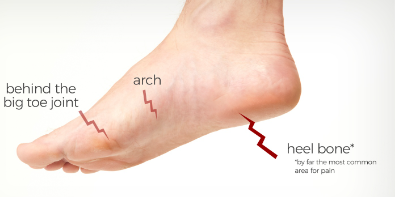condition that causes heel pain, particularly in the morning or after long periods of rest. This condition occurs due to inflammation of the plantar fascia, a thick band of tissue connecting the heel bone to the toes. Without proper treatment, plantar fasciitis can lead to chronic pain and mobility issues. Fortunately, low-intensity shockwave therapy has emerged as a revolutionary treatment option, providing long-term relief from this debilitating condition.
Table of Contents
1. Overuse or Excessive Strain
2. Improper Footwear
3. Obesity or Weight Gain
4. Flat Feet or High Arches
5. Tight Achilles Tendon: Traditional Treatment Options for Plantar Fasciitis
Physical Therapy
How Low-Intensity Shockwave Therapy Helps in Plantar Fasciitis Relief. There are benefits of low-intensity shockwave therapy for plantar pain relief in Mount Pleasant. Choose Apollo Wave for Plantar Fasciitis Shockwave How Long Does It Take to See Results. Preventing Plantar Fasciitis
1. Wear Supportive Footwear
2. Maintain a Healthy Weight
3. Stretch Regularly
4. Avoid High-Impact Activities Final Thoughts
plantar fasciitis
Plantar fasciitis is the leading cause of heel pain, affecting millions of people worldwide. It occurs when the plantar fascia becomes irritated or inflamed due to excessive strain. The condition is common among athletes, individuals who stand for long hours, and people with obesity or improper footwear. Symptoms of plantar fasciitis: sharp pain in the bottom of the heel, discomfort that worsens in the morning, increased pain after standing for long hours, swelling, and tenderness in the heel area. If left untreated, plantar fasciitis can become a chronic issue, leading to severe foot problems.
1. Rest & Ice
Therapy Sometimes, the best thing you can do is give your feet a break. Avoid standing or walking for long periods, and apply an ice pack to the painful area for 15–20 minutes a few times a day. This helps reduce swelling and soothes inflammation.
2. Gentle Stretching
Stretching the arches of your feet, calves, and Achilles tendon can relieve tension and improve flexibility. A few simple exercises each morning and evening can make a huge difference over time.
3. Orthotic Shoe
Inserts support matters! Wearing custom or over-the-counter orthotic inserts can help align your foot properly, distribute pressure more evenly, and reduce strain, especially if you’re on your feet all day.
4. Anti-Inflammatory
Anti-Inflammatory Medications Over-the-counter options like ibuprofen or naproxen can reduce pain and swelling when things get uncomfortable. Just be sure to follow dosage instructions and check with a doctor if needed.
Causes of Plantar Fasciitis:
Causes of Plantar Fasciitis: Several factors contribute to the development of plantar fasciitis. Understanding these causes can help in prevention and management. Overuse or Excessive Strain High-impact activities such as running, jumping, and standing for long periods put significant stress on the plantar fascia, leading to inflammation. Improper Footwear: Wearing shoes without proper arch support or cushioning can lead to increased strain on the foot. High heels, flat shoes, and worn-out footwear can also contribute to plantar fasciitis. Obesity or Weight Gain: Excess body weight puts additional pressure on the feet, increasing the risk of inflammation in the plantar fascia.
Arches Individuals
Flat Feet or High Arches Individuals with flat feet or high arches experience uneven weight distribution, causing additional stress on the plantar fascia. Tight Achilles Tendon A tight Achilles tendon limits foot flexibility, increasing the chances of developing plantar fasciitis. Traditional Treatment Options for Plantar Fasciitis Several conventional treatments provide temporary relief from plantar fasciitis pain. However, these methods may not always address the root cause of the problem. Rest and Ice Therapy: Reducing activities that worsen pain and applying ice to the affected area helps in managing inflammation. Stretching Exercises Regular stretching of the calf muscles and plantar fascia improves flexibility and reduces tension. Orthotic Shoe Inserts Customized shoe inserts provide additional arch support, reducing strain on the plantar fascia. Anti-Inflammatory Medications Over-the-counter pain relievers like ibuprofen and naproxen help reduce inflammation.
Physical Therapy
A trained physical therapist can provide exercises and techniques to improve foot strength and mobility. While these treatments provide short-term relief, they may not be effective in eliminating plantar fasciitis permanently. How Low-Intensity Shockwave Therapy Helps in Plantar Fasciitis Relief. One of the most promising treatments for plantar fasciitis pain relief is low-intensity shockwave therapy. This non-invasive treatment stimulates natural healing and reduces pain by targeting the root cause of inflammation. Low-intensity shockwave therapy uses acoustic waves to stimulate blood flow and promote tissue regeneration in the affected area. This therapy helps break down scar tissue, reduce inflammation, and enhance the healing process.
Benefits of Shockwave
Benefits of Shockwave Therapy for Plantar Fasciitis: Non-surgical and Drug-Free Treatment. No need for medications or invasive procedures. Accelerated Healing Process: Enhances blood circulation, promoting tissue repair. Long-Lasting Pain Relief: Targets the root cause of pain for sustained relief. Improved Mobility: Restores foot function, allowing patients to walk pain-free. Plantar Fasciitis Pain Relief in Mount Pleasant, SC If you are looking for plantar fasciitis pain relief in Mount Pleasant, SC, low-intensity shockwave therapy is an effective treatment option. This non-invasive procedure helps individuals recover faster without the need for surgery or prolonged medication use. Clinics specializing in shockwave therapy offer customized treatment plans to address the root cause of plantar fasciitis and provide long-term relief. Choose Apollo Wave for plantar fasciitis treatment. At Apollo Wave, patients receive advanced shockwave therapy for treating plantar fasciitis effectively.

Plantar fasciitis is a common foot
innovative treatment
This innovative treatment approach helps individuals regain their active lifestyle without surgery or prolonged medication use. Benefit from shockwave therapy. Shockwave therapy is suitable for individuals experiencing chronic plantar fasciitis pain. It is an excellent option for athletes recovering from sports-related injuries. People suffering from chronic foot pain, individuals seeking an alternative therapy, and those who have tried traditional treatments without success. It Takes Time to See Results. Most patients experience improvement within 3-5 sessions of shockwave therapy. The healing process varies depending on the severity of the condition, but many report significant pain reduction after the first few treatments. Preventing Plantar Fasciitis. While shockwave therapy provides effective relief, it is essential to take preventive measures to avoid recurrence.
Wear supportive footwear. Invest in shoes with proper arch support and cushioning to prevent excessive strain. Maintain a Healthy Weight. Reducing body weight decreases pressure on the feet, preventing inflammation. Stretch Regularly stretching the calves and plantar fascia keeps the foot muscles flexible and reduces tension. Avoid High-Impact Activities. Switching to low-impact exercises like swimming and cycling can reduce stress on the feet.
Final Thoughts
Final Thoughts: Plantar fasciitis can be a painful and frustrating condition, but effective treatment options are available. Low-intensity shockwave therapy is a breakthrough solution for those struggling with chronic foot pain. If you are looking for a non-invasive, drug-free way to relieve plantar fasciitis, apollo-wave.com offers advanced treatment options tailored to your needs. Take the first step toward pain-free living today! Facebook, Mastodon, and Email Share
Conclusion
Plantar Fasciitis Plantar fasciitis might sound like a complicated medical term, but for many people, it simply means constant heel pain that just won’t go away, especially in the morning or after standing for a long time. The good news? It’s treatable. And in most cases, you don’t need surgery or extreme measures to find relief. The key is to catch it early and treat it gently but consistently. Resting your feet, applying ice, wearing proper footwear, and doing simple stretches can all go a long way.
Orthotic inserts and anti-inflammatory medication may also provide support during flare-ups. But remember—healing takes time. It’s easy to get frustrated when pain doesn’t go away overnight. Be patient with your body. Give it the care, rest, and support it needs to recover. If your pain persists or worsens, don’t ignore it. Consult a doctor or foot specialist (podiatrist) to rule out more serious conditions and get personalized treatment. Your feet carry you through life—treat them with kindness. The small steps you take today can prevent bigger problems tomorrow.
FQS
Who Is Most at Risk?
Plantar fasciitis is common in: People over 40 and athletes or runners. Overweight individuals, People with flat feet or very high arches, Workers who stand for long hours (like nurses, teachers, or factory workers)
How is plantar fasciitis diagnosed?
Doctors usually diagnose it by asking about your symptoms, examining your feet, and checking for tenderness in the heel and arch. X-rays or MRIs are rarely needed unless your doctor suspects something else (like a heel spur or stress fracture).
How Can I Treat It at Home?
Here are simple treatments you can try: Rest your feet— Avoid activities that make it worse Ice the heel—15–20 minutes, a few times a day. Stretching exercises—especially your calves and foot arches. Supportive footwear—Use cushioned shoes or orthotic inserts. Pain relievers—over-the-counter anti-inflammatory medications like ibuprofen
How Long Does It Take to Heal?
With the right care, most people feel better in a few weeks to a few months. However, healing can be slow, especially if the cause isn’t addressed (like poor shoes or tight muscles).
When Should I See a Doctor?
See a doctor if: The pain lasts more than a few weeks, it’s affecting your daily life. Home treatments don’t help. The pain feels severe or gets worse. A specialist might recommend physical therapy, custom orthotics, or, in rare cases, injections or surgery.
Can I Prevent Plantar Fasciitis?
Yes! You can reduce your risk by: Wearing supportive shoes (avoid flip-flops or flat soles), Stretching your calves and feet regularly, Maintaining a healthy weight, Taking breaks if you stand or walk for long hours Replacing worn-out shoes, especially if you run or walk a lot






Leave a Reply